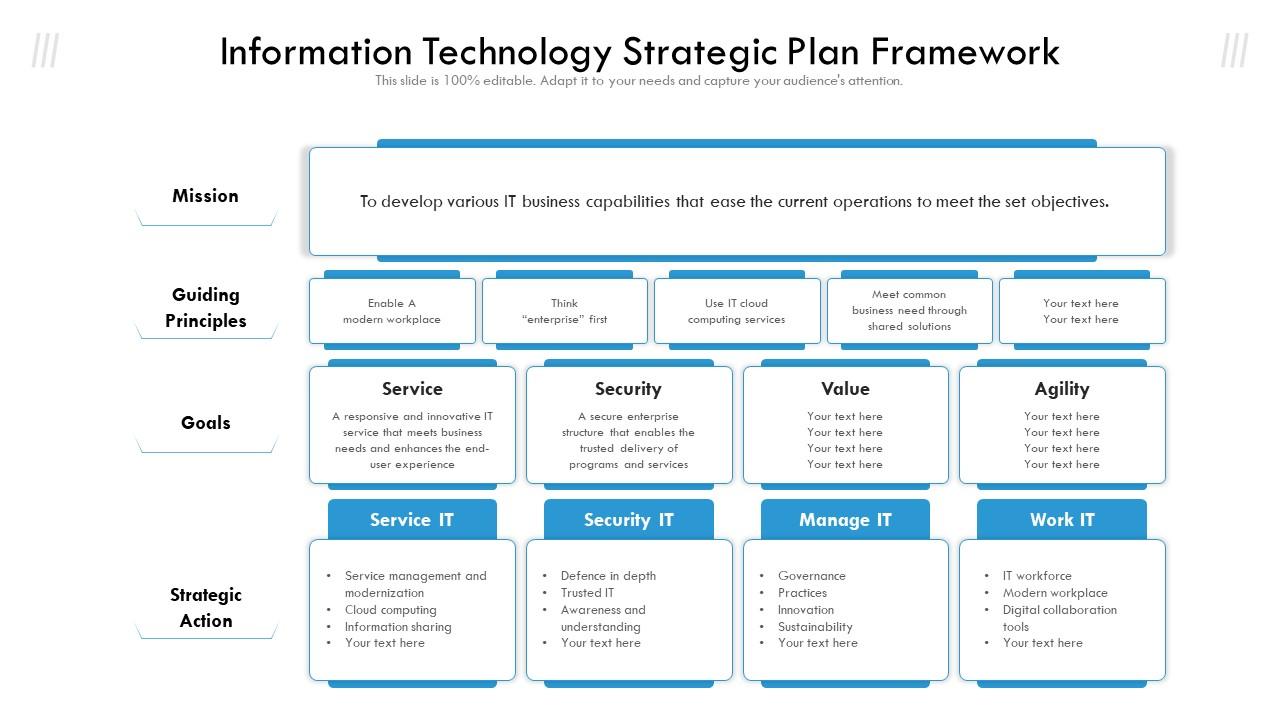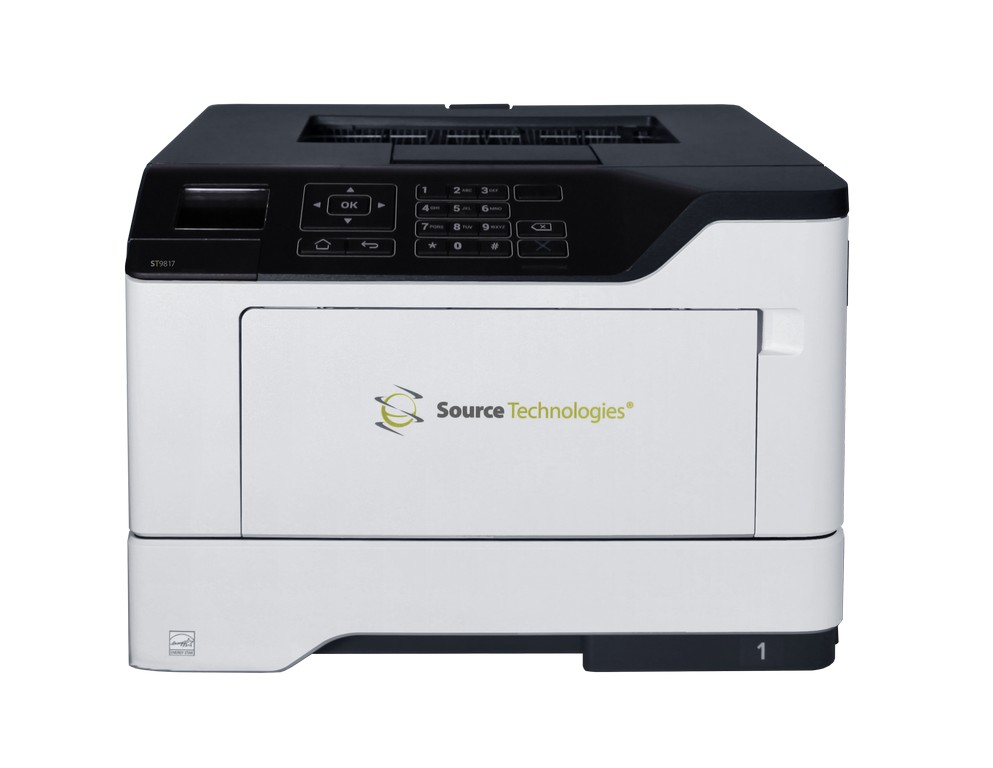Information Technology Strategy Presentation: A Roadmap for Success
Information Technology Strategy Presentation: A Roadmap for Success, this presentation delves into the critical importance of a well-defined IT strategy for organizational success. We’ll explore how a comprehensive IT strategy […]

Information Technology Strategy Presentation: A Roadmap for Success, this presentation delves into the critical importance of a well-defined IT strategy for organizational success. We’ll explore how a comprehensive IT strategy can align with business goals, drive innovation, and navigate the complex landscape of technology. This journey will equip you with the knowledge and tools to develop and implement a robust IT strategy that positions your organization for sustainable growth and competitive advantage.
From assessing your current IT infrastructure and capabilities to defining clear goals and objectives, we’ll guide you through the process of creating a roadmap for successful IT implementation. We’ll also discuss emerging technologies, cybersecurity, budgeting, and stakeholder engagement, ensuring that your IT strategy is comprehensive and adaptable to the ever-evolving technological landscape.
The Importance of an Information Technology Strategy
In today’s rapidly evolving digital landscape, a comprehensive information technology (IT) strategy is no longer a luxury but a necessity for any organization seeking sustained success. A well-defined IT strategy serves as a roadmap, guiding an organization’s technology investments, infrastructure development, and digital transformation initiatives, ensuring they align with overall business goals and objectives.
The Impact of a Well-Defined IT Strategy on Business Goals
A robust IT strategy can directly contribute to an organization’s success by fostering alignment between technology and business objectives.
- Enhanced Efficiency and Productivity: By leveraging technology to streamline processes, automate tasks, and optimize workflows, organizations can significantly enhance operational efficiency and productivity. For example, implementing a cloud-based enterprise resource planning (ERP) system can automate financial processes, reduce manual errors, and improve data visibility across departments, leading to greater efficiency and productivity.
- Improved Customer Experience: A well-defined IT strategy can enable organizations to deliver exceptional customer experiences. By investing in technologies that enhance customer interactions, such as online self-service portals, mobile apps, and personalized communication channels, organizations can improve customer satisfaction, loyalty, and advocacy.
- Competitive Advantage: By embracing cutting-edge technologies and innovative solutions, organizations can gain a competitive edge in their respective industries. For instance, adopting artificial intelligence (AI) for data analysis and predictive modeling can provide valuable insights, optimize decision-making, and drive revenue growth.
- Innovation and Growth: An IT strategy that encourages experimentation, fosters a culture of innovation, and supports the development of new products and services can drive growth and expansion.
Key Components of an IT Strategy
A robust IT strategy isn’t simply a collection of technology choices; it’s a roadmap that aligns technology with your business goals. It defines how you’ll leverage technology to achieve competitive advantage, improve efficiency, and drive innovation.
Business Objectives and Alignment
A well-defined IT strategy starts with understanding your business goals and aligning your technology investments with them. This means clearly defining what you want to achieve through technology, whether it’s increasing revenue, improving customer experience, or reducing operational costs.
- Identify Key Business Objectives: What are your company’s primary goals for the next few years? Are you aiming for growth, cost optimization, market expansion, or something else entirely?
- Translate Objectives into IT Requirements: Once you know your business objectives, you can translate them into specific IT needs. For example, if your goal is to increase revenue through online sales, you’ll need to invest in a robust e-commerce platform, secure payment processing, and effective online marketing tools.
Technology Architecture and Infrastructure
The technology architecture and infrastructure form the backbone of your IT strategy. This component Artikels the hardware, software, and network infrastructure required to support your business operations and applications.
- Evaluate Current Infrastructure: Begin by assessing your existing IT infrastructure. Are your systems outdated? Do they meet your current and future needs?
- Define Future Infrastructure: Based on your business objectives and technology roadmap, you need to define the future infrastructure. This might involve adopting cloud services, upgrading your network, or investing in new software solutions.
Data Management and Security
In today’s data-driven world, data management and security are crucial components of any IT strategy. This component Artikels how you’ll collect, store, manage, and protect your valuable data assets.
- Data Security Policies: Implement robust security measures to protect your data from unauthorized access, breaches, and cyber threats.
- Data Governance and Compliance: Establish clear data governance policies to ensure data quality, integrity, and compliance with relevant regulations.
Innovation and Emerging Technologies
Staying ahead of the curve requires embracing innovation and exploring emerging technologies. This component focuses on identifying and evaluating new technologies that can help your business gain a competitive edge.
- Emerging Technology Trends: Research and identify promising technologies like artificial intelligence, blockchain, or the Internet of Things (IoT) that can potentially transform your industry.
- Pilot Projects and Proof of Concepts: Before full-scale implementation, conduct pilot projects or proof-of-concept studies to assess the feasibility and value of new technologies.
IT Governance and Management
Effective IT governance and management are essential for ensuring your IT strategy aligns with your business goals and is implemented effectively. This component defines the roles, responsibilities, and processes for managing your IT resources.
- IT Governance Framework: Establish a clear IT governance framework that Artikels decision-making processes, accountability, and risk management strategies.
- IT Service Management (ITSM): Implement ITSM best practices to manage IT services, incidents, and problems effectively.
Talent and Skills
Technology is only as good as the people who use it. This component focuses on developing the IT skills and expertise needed to implement and manage your IT strategy.
- Skills Gap Analysis: Identify any gaps between the skills you have and the skills you need to execute your IT strategy.
- Training and Development: Invest in training programs to upskill your IT team and ensure they have the necessary expertise to handle emerging technologies.
Budget and Resource Allocation
Every IT strategy requires careful budget planning and resource allocation. This component Artikels how you’ll fund your IT initiatives and prioritize investments based on their impact on your business goals.
- Cost-Benefit Analysis: Conduct thorough cost-benefit analyses for each IT investment to ensure it aligns with your budget and provides a return on investment.
- Resource Allocation: Allocate resources, including personnel, time, and budget, to ensure the successful implementation of your IT strategy.
Assessing Current IT Infrastructure and Capabilities
A thorough assessment of your existing IT infrastructure is crucial for developing a successful information technology strategy. It provides a clear understanding of your current capabilities, limitations, and potential areas for improvement. This assessment serves as a foundation for informed decision-making regarding technology investments, resource allocation, and strategic planning.
Evaluating Current IT Capabilities
Understanding your current IT capabilities is essential for identifying strengths, weaknesses, and opportunities for improvement. A comprehensive evaluation framework can help you assess various aspects of your IT infrastructure, including:
IT Infrastructure Assessment Framework
- Hardware and Software: Evaluate the age, performance, and capacity of your hardware and software components. Identify any outdated or underperforming systems that require upgrades or replacements. Consider the compatibility and interoperability of different systems and applications.
- Network Infrastructure: Assess the performance, reliability, and security of your network infrastructure, including routers, switches, and firewalls. Evaluate the bandwidth capacity, latency, and network security measures. Identify any bottlenecks or vulnerabilities that require attention.
- Data Management and Storage: Analyze your data storage capacity, data security measures, and data management processes. Evaluate the efficiency and effectiveness of your data backup and recovery procedures. Consider the use of cloud storage and other data management solutions.
- Security Posture: Assess your organization’s security posture, including vulnerability management, threat detection, and incident response capabilities. Evaluate the effectiveness of your security policies, procedures, and technologies. Identify any gaps or weaknesses in your security measures.
- IT Service Management: Evaluate the effectiveness of your IT service management processes, including incident management, problem management, and change management. Assess the availability, performance, and reliability of your IT services. Identify any areas for improvement in service delivery and support.
- IT Governance and Compliance: Evaluate your IT governance framework, including policies, procedures, and controls. Assess your compliance with relevant industry regulations and standards. Identify any gaps or weaknesses in your IT governance structure.
- IT Talent and Skills: Assess the skills, experience, and qualifications of your IT staff. Identify any skill gaps or areas where additional training or development is needed. Consider the availability of qualified IT professionals in the market.
- IT Budget and Resources: Evaluate your IT budget, resource allocation, and spending patterns. Identify any areas where cost optimization or resource reallocation may be possible. Consider the impact of emerging technologies and trends on your IT budget.
Key Aspects of IT Infrastructure Assessment
| Aspect | Description | Evaluation Criteria |
|---|---|---|
| Hardware | Servers, workstations, storage devices, network equipment | Age, performance, capacity, reliability, security, energy efficiency |
| Software | Operating systems, applications, databases, security software | Version, compatibility, performance, security, licensing, support |
| Network | Network infrastructure, including routers, switches, firewalls | Bandwidth, latency, reliability, security, scalability |
| Data Management | Data storage, backup, recovery, security, compliance | Capacity, performance, security, efficiency, cost-effectiveness |
| Security | Vulnerability management, threat detection, incident response | Security policies, procedures, technologies, effectiveness |
| IT Service Management | Incident management, problem management, change management | Availability, performance, reliability, efficiency, customer satisfaction |
| IT Governance | Policies, procedures, controls, compliance | Effectiveness, efficiency, alignment with business objectives |
| IT Talent | Skills, experience, qualifications, availability | Alignment with business needs, training and development |
| IT Budget | Resource allocation, spending patterns, cost optimization | Efficiency, effectiveness, alignment with business objectives |
Defining IT Goals and Objectives
An effective IT strategy requires clear, measurable, and aligned IT goals. These goals should not be isolated but rather integrated with the overall business objectives, ensuring that IT investments and initiatives directly contribute to the organization’s success.
Aligning IT Goals with Business Objectives
The alignment of IT goals with business objectives is crucial for maximizing the return on IT investments. It ensures that IT initiatives support the organization’s strategic priorities and contribute to its overall success. To achieve this alignment, organizations need to:
- Understand the Business Strategy: Start by clearly understanding the organization’s overarching business strategy, including its vision, mission, and strategic goals. This understanding provides a framework for identifying the IT goals that will support the business objectives.
- Identify Key Business Drivers: Determine the key business drivers that contribute to the organization’s success. These drivers might include revenue growth, market share expansion, customer satisfaction, or operational efficiency. IT goals should be aligned with these drivers to ensure that IT initiatives directly contribute to the desired outcomes.
- Translate Business Objectives into IT Goals: Once the business strategy and key drivers are understood, translate them into specific IT goals. This involves identifying how IT can enable and support the achievement of each business objective. For example, if the business goal is to increase customer satisfaction, an IT goal might be to implement a new customer relationship management (CRM) system to enhance customer interactions and provide better service.
SMART IT Goals
SMART goals are essential for providing clarity, focus, and accountability in IT initiatives. SMART stands for:
- Specific: IT goals should be clearly defined, leaving no room for ambiguity or misinterpretation. For example, instead of “Improve customer service,” a more specific goal could be “Reduce average customer response time to inquiries by 20% within the next quarter.”
- Measurable: IT goals should be quantifiable, allowing progress to be tracked and measured. This ensures that the effectiveness of IT initiatives can be assessed objectively. For example, “Increase website traffic by 15% within six months” is a measurable goal.
- Achievable: IT goals should be realistic and attainable within the organization’s resources and capabilities. Setting overly ambitious goals can lead to frustration and failure. For example, “Reduce IT infrastructure costs by 50% within one year” might be unrealistic and difficult to achieve without significant changes in the organization’s IT environment.
- Relevant: IT goals should be aligned with the overall business strategy and contribute to the achievement of key business objectives. This ensures that IT investments are focused on areas that drive business value. For example, “Improve employee productivity by 10% through the implementation of a new collaboration tool” is a relevant goal if the business objective is to increase efficiency and reduce operational costs.
- Time-bound: IT goals should have a clear deadline or timeframe for completion. This provides a sense of urgency and accountability, ensuring that initiatives are completed within a reasonable time frame. For example, “Implement a new data security system within the next six months” is a time-bound goal.
Prioritizing and Articulating IT Goals
Once IT goals are defined, they need to be prioritized based on their alignment with business objectives and their potential impact on the organization’s success. This prioritization process helps ensure that IT resources are allocated effectively and that the most critical goals are addressed first.
- Impact Assessment: Assess the potential impact of each IT goal on the organization’s key business drivers and strategic objectives. This assessment can be based on qualitative and quantitative factors, such as revenue growth, cost reduction, customer satisfaction, or market share expansion.
- Resource Allocation: Allocate IT resources, including budget, personnel, and time, based on the priority of each goal. The most critical goals should receive the most resources and attention.
- Communication and Alignment: Clearly communicate the prioritized IT goals to all stakeholders, including business leaders, IT personnel, and employees. This ensures that everyone is aligned on the organization’s IT strategy and understands the role they play in achieving the goals.
Developing a Roadmap for IT Implementation
An IT implementation roadmap is a crucial component of any successful IT strategy. It Artikels the steps, timelines, and resources required to achieve your IT goals and objectives. A well-defined roadmap ensures that your IT projects are delivered on time, within budget, and meet your business needs.
Defining the Scope and Objectives, Information technology strategy presentation
The first step in developing an IT implementation roadmap is to define the scope and objectives of your IT projects. This involves clearly identifying what you want to achieve with your IT initiatives. For example, if you are implementing a new CRM system, your objectives might include improving customer satisfaction, streamlining sales processes, and gaining a better understanding of your customer base.
Identifying Key Milestones and Timelines
Once you have defined the scope and objectives of your IT projects, you need to identify key milestones and timelines. Milestones are significant points in your project that represent progress towards your objectives. Timelines are the deadlines for completing each milestone.
For example, if you are implementing a new ERP system, some key milestones might include:
- Project kickoff meeting
- Requirements gathering and analysis
- System design and development
- Testing and quality assurance
- System implementation and training
- Go-live and post-implementation support
Creating a Visual Representation of the IT Roadmap
A visual representation of the IT roadmap can be very helpful in communicating your plans to stakeholders. This can be done using a timeline or flowchart.
For example, a timeline could show the start and end dates for each milestone, as well as the dependencies between milestones. A flowchart could show the different phases of your IT project, as well as the decision points and approval processes.
Resource Allocation and Budget Planning
Once you have defined your milestones and timelines, you need to allocate resources and plan your budget. This involves identifying the people, equipment, and software that you will need to complete your IT projects. It also involves determining the cost of each resource and creating a budget for your projects.
Monitoring and Evaluation
Finally, it is important to monitor and evaluate your IT implementation roadmap. This involves tracking your progress against your milestones and timelines, and making adjustments as needed. It also involves evaluating the effectiveness of your IT projects and identifying areas for improvement.
Example IT Roadmap Timeline
| Milestone | Timeline | Resources |
|---|---|---|
| Project Kickoff Meeting | Week 1 | Project Manager, IT Team, Stakeholders |
| Requirements Gathering and Analysis | Week 2 – 4 | Business Analysts, IT Team, Stakeholders |
| System Design and Development | Week 5 – 12 | Software Developers, IT Team, Vendors |
| Testing and Quality Assurance | Week 13 – 16 | QA Team, IT Team, Users |
| System Implementation and Training | Week 17 – 20 | IT Team, Trainers, Users |
| Go-Live and Post-Implementation Support | Week 21 onwards | IT Team, Support Team, Users |
An IT implementation roadmap should be a living document that is regularly reviewed and updated. As your business needs evolve, your IT roadmap should be adjusted accordingly.
Technology Adoption and Innovation: Information Technology Strategy Presentation
Staying ahead of the curve in technology is crucial for any organization aiming to maintain a competitive edge. Embracing emerging technologies and fostering innovation within your IT strategy can unlock new opportunities, improve efficiency, and enhance customer experiences.
The Impact of Emerging Technologies
Emerging technologies have a profound impact on IT strategies, driving innovation and reshaping the business landscape. These technologies offer unprecedented opportunities to enhance operations, improve decision-making, and create new revenue streams.
- Artificial Intelligence (AI) and Machine Learning (ML): AI and ML are transforming various industries by automating tasks, analyzing data, and providing insights. These technologies can optimize processes, personalize customer experiences, and drive innovation in areas such as fraud detection, predictive maintenance, and personalized recommendations.
- Cloud Computing: Cloud computing has revolutionized IT infrastructure, providing organizations with scalable and flexible resources on demand. It enables businesses to access powerful computing capabilities without significant upfront investments, fostering agility and reducing operational costs.
- Internet of Things (IoT): The IoT connects physical devices to the internet, enabling data collection and real-time insights. This technology can enhance operational efficiency, improve safety, and create new business models, particularly in industries such as manufacturing, healthcare, and transportation.
- Blockchain: Blockchain technology offers secure and transparent data management, revolutionizing industries such as finance, supply chain management, and healthcare. Its decentralized nature ensures data integrity and immutability, promoting trust and transparency.
- 5G and Edge Computing: 5G networks provide ultra-fast speeds and low latency, enabling real-time data processing and communication. Edge computing brings processing power closer to data sources, reducing latency and improving responsiveness, particularly in applications requiring real-time decision-making.
Identifying Key Technology Trends
Staying informed about emerging technologies and their potential impact is essential for organizations to adapt and thrive. Regularly assessing technology trends can help you identify opportunities for innovation and address potential challenges.
- Quantum Computing: Quantum computing has the potential to revolutionize scientific research, drug discovery, and materials science. It can solve complex problems that are currently intractable for classical computers, unlocking new possibilities in various fields.
- Cybersecurity Advancements: Cybersecurity threats are constantly evolving, necessitating continuous adaptation and innovation. Emerging technologies such as AI and ML are playing a crucial role in strengthening cybersecurity defenses and protecting sensitive data.
- Extended Reality (XR): XR technologies, including virtual reality (VR), augmented reality (AR), and mixed reality (MR), are transforming industries such as training, education, and entertainment. They provide immersive experiences, enhancing learning and engagement.
- Sustainable Technology: Environmental concerns are driving innovation in sustainable technologies. Organizations are increasingly adopting energy-efficient solutions, renewable energy sources, and carbon-neutral practices to minimize their environmental impact.
Innovative IT Solutions and their Benefits
Implementing innovative IT solutions can significantly enhance an organization’s performance and competitiveness.
- AI-powered Customer Service Chatbots: AI-powered chatbots can provide 24/7 customer support, automating responses to frequently asked questions and resolving issues efficiently. This can improve customer satisfaction and reduce operational costs.
- Predictive Maintenance using IoT Sensors: IoT sensors can monitor equipment performance and identify potential issues before they occur. This proactive approach to maintenance can prevent costly downtime and optimize asset utilization.
- Blockchain-based Supply Chain Management: Blockchain can enhance transparency and traceability in supply chains, reducing fraud and counterfeiting. It can also streamline processes and improve efficiency, ensuring product quality and authenticity.
- Cloud-based Collaboration Tools: Cloud-based collaboration tools enable teams to work together seamlessly, regardless of location. This fosters communication, improves productivity, and facilitates remote work.
Security and Risk Management
In today’s digital landscape, cybersecurity is no longer a mere afterthought but a fundamental pillar of any successful IT strategy. A robust security framework is essential for protecting sensitive data, maintaining operational continuity, and safeguarding the organization’s reputation.
Addressing Potential Security Risks and Vulnerabilities
A comprehensive plan for addressing security risks and vulnerabilities involves a multi-layered approach that encompasses proactive measures, reactive responses, and ongoing monitoring.
Proactive Security Measures
- Regular Security Audits and Assessments: Conducting regular security audits and assessments helps identify vulnerabilities and weaknesses in the IT infrastructure. These audits should cover all aspects of the system, including hardware, software, network, and applications.
- Implementation of Strong Access Controls: Implementing strong access controls, such as multi-factor authentication and role-based access, restricts unauthorized access to sensitive data and systems.
- Employee Security Awareness Training: Educating employees about cybersecurity best practices, such as phishing awareness and password hygiene, helps minimize the risk of human error.
- Regular Software and System Updates: Keeping software and systems up to date with the latest security patches is crucial for addressing known vulnerabilities.
- Network Segmentation: Dividing the network into smaller, isolated segments limits the impact of a security breach by preventing attackers from accessing sensitive data across the entire network.
Reactive Security Measures
- Incident Response Plan: A well-defined incident response plan Artikels the steps to be taken in the event of a security breach, including containment, recovery, and post-incident analysis.
- Data Backup and Recovery: Regular data backups ensure that data can be restored in the event of a security breach or system failure.
- Security Monitoring and Logging: Continuous monitoring of network traffic, system logs, and security events helps detect suspicious activity and potential threats.
Implementing Effective Risk Management Practices
Effective risk management practices involve a structured approach to identifying, assessing, and mitigating potential risks within the IT environment.
Risk Identification and Assessment
- Identify Potential Risks: A comprehensive risk assessment involves identifying all potential threats to the IT infrastructure, including internal and external threats, such as cyberattacks, natural disasters, and human error.
- Assess Risk Likelihood and Impact: Once risks are identified, they should be assessed based on their likelihood of occurrence and the potential impact on the organization. This helps prioritize risks and focus resources on the most critical areas.
Risk Mitigation Strategies
- Implement Controls: Appropriate controls should be implemented to mitigate identified risks. These controls can be technical, administrative, or physical, and should be tailored to the specific risk.
- Risk Transfer: In some cases, it may be appropriate to transfer risk to a third party, such as through insurance or outsourcing.
- Risk Acceptance: Some risks may be accepted if the likelihood of occurrence is low and the potential impact is minimal.
Ongoing Risk Management
- Regular Reviews and Updates: The risk management process should be regularly reviewed and updated to reflect changes in the IT environment, business operations, and threat landscape.
- Continuous Monitoring and Evaluation: Ongoing monitoring and evaluation of risk mitigation strategies ensure that they remain effective and that new risks are identified promptly.
Budgeting and Resource Allocation
Developing a sound IT strategy requires careful consideration of financial aspects. Allocating resources effectively is crucial for successful implementation and achieving desired outcomes.
Financial Considerations
The financial implications of an IT strategy should be thoroughly assessed. This involves understanding the costs associated with various components, including hardware, software, infrastructure, personnel, training, and ongoing maintenance. It’s important to consider the potential return on investment (ROI) and how the IT strategy aligns with overall business goals.
Budget Allocation Plan
A comprehensive budget allocation plan helps prioritize IT projects and initiatives. It involves identifying the most critical needs and allocating funds accordingly. A structured approach can be used to create a budget allocation plan:
- Prioritize Projects: Categorize IT projects based on their importance and potential impact on business objectives.
- Estimate Costs: Determine the estimated costs for each project, including hardware, software, labor, and other expenses.
- Allocate Funds: Allocate budget resources to projects based on their priority and cost estimates.
- Track Expenses: Monitor actual expenses against the allocated budget to ensure financial control.
Optimizing IT Resource Utilization
Maximizing the efficiency of IT resources is essential for cost optimization and improved performance. Strategies for optimizing IT resource utilization include:
- Cloud Computing: Leveraging cloud services can reduce hardware and infrastructure costs, enabling on-demand access to resources.
- Software Licensing Optimization: Negotiating favorable software licensing agreements and utilizing volume discounts can significantly reduce software costs.
- Virtualization: Virtualizing servers and applications can consolidate hardware resources, reducing energy consumption and maintenance costs.
- Automation: Automating repetitive tasks can free up IT staff for more strategic initiatives, improving efficiency and reducing labor costs.
Communication and Stakeholder Engagement
Effective communication is crucial for the successful implementation of an IT strategy. It fosters transparency, alignment, and buy-in from all stakeholders, ensuring that everyone is on the same page and working towards the same goals. Without effective communication, misunderstandings, delays, and resistance can arise, hindering progress and jeopardizing the success of the IT strategy.
Engaging Key Stakeholders
Engaging key stakeholders throughout the IT strategy development and implementation process is essential for achieving buy-in, gathering valuable insights, and ensuring that the strategy addresses their needs and concerns.
- Identify and prioritize stakeholders: Begin by identifying all individuals or groups who will be impacted by the IT strategy, including senior management, employees, customers, partners, and vendors. Prioritize stakeholders based on their influence and impact on the success of the strategy.
- Establish communication channels: Choose appropriate communication channels to reach each stakeholder group effectively. This could include meetings, emails, newsletters, presentations, intranet updates, or dedicated online platforms.
- Tailor communication style and content: Adapt the communication style and content to suit the specific needs and preferences of each stakeholder group. For instance, technical details might be more relevant to IT staff, while business executives may be more interested in the strategic impact and return on investment.
- Provide regular updates: Keep stakeholders informed about the progress of the IT strategy implementation. This could include regular reports, presentations, or updates on key milestones achieved.
- Foster open dialogue: Encourage open communication and feedback from stakeholders. This can be done through meetings, surveys, or dedicated forums for gathering feedback and addressing concerns.
Developing a Communication Plan
A well-defined communication plan Artikels the key messages, target audiences, communication channels, and timelines for disseminating information and updates related to the IT strategy.
- Define key messages: Clearly articulate the main objectives, benefits, and potential impact of the IT strategy in a concise and compelling manner.
- Identify target audiences: Segment stakeholders into different groups based on their roles, interests, and information needs. This will help tailor communication efforts to specific audiences.
- Choose communication channels: Select appropriate channels for reaching each target audience, considering their preferred methods of communication and the nature of the information being shared.
- Establish communication frequency: Determine the frequency of communication updates based on the importance of the information and the needs of stakeholders. Regular updates can help keep stakeholders informed and engaged.
- Measure communication effectiveness: Track the effectiveness of communication efforts by monitoring feedback, engagement levels, and the achievement of communication objectives.
Monitoring and Evaluation
A well-defined IT strategy needs constant monitoring and evaluation to ensure its effectiveness and alignment with evolving business needs. This involves tracking progress, measuring success, and identifying areas for improvement.
Key Performance Indicators (KPIs)
KPIs are crucial for tracking progress and measuring the success of the IT strategy. They provide quantifiable metrics to assess performance against established goals.
- System Uptime: Measures the percentage of time systems are operational and available for users. This KPI reflects system reliability and performance.
- Mean Time Between Failures (MTBF): Measures the average time between system failures. A higher MTBF indicates greater system stability and fewer disruptions.
- Return on Investment (ROI): Calculates the financial benefits generated by IT investments. This KPI assesses the cost-effectiveness of IT initiatives.
- Customer Satisfaction: Measures user satisfaction with IT services and support. This KPI reflects the effectiveness of IT in meeting user needs.
- Security Incident Response Time: Measures the time taken to identify and address security breaches. This KPI reflects the effectiveness of security measures and incident response capabilities.
Framework for Evaluating IT Initiatives
A structured framework is essential for evaluating the effectiveness of IT initiatives. This framework should include a combination of qualitative and quantitative assessments.
- Alignment with Business Goals: Assess how well IT initiatives align with overall business objectives and strategic priorities.
- Cost-Effectiveness: Evaluate the financial return on IT investments, considering both tangible and intangible benefits.
- User Adoption and Satisfaction: Assess the extent to which users have adopted and are satisfied with new IT systems and services.
- Risk Management: Evaluate the effectiveness of risk mitigation strategies implemented within IT initiatives.
- Performance Measurement: Track key performance indicators (KPIs) to monitor progress and measure the success of IT initiatives.
Closure

By embracing a strategic approach to information technology, organizations can harness the power of innovation, enhance operational efficiency, and drive growth. As we conclude this presentation, we encourage you to consider the insights gained and to embark on the journey of crafting a compelling IT strategy that empowers your organization to thrive in the digital age.
A well-structured information technology strategy presentation should clearly outline your goals and objectives. If you need help understanding the technical aspects of your strategy, consider seeking guidance from an information technology tutor. A tutor can provide personalized instruction and support, ensuring you have the knowledge to effectively communicate your strategy to stakeholders.










